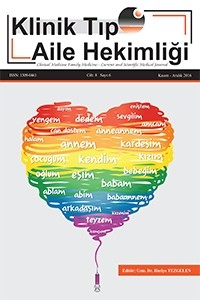Selektif Mutizm Olgusu
ÖzSelektif mutizm (SM) normal ve sosyal ortamlarda konuşmama fakat ebeveyn ve kardeş gibi yakın ilişkilerin olduğu ortamlarda konuşma olarak tanımlanabilir. Nedeni tamolarak belirlenememiştir fakat çekingenlik ve utangaçlık özellikleri, travmatik yaşantılar, olumsuz ebeveyn tutumları ve dil gelişimi sorunlarının SM’ye yol açabileceği bildirilmiştir. Yaygınlık oranları çeşitli çalışmalarda farklılık göstermekte ise de yaklaşık%2 olduğu belirtilmiştir ve kızlarda daha fazla görülür. SM’nin dört alt türü bulunmaktadır ve tanıya genellikle okul başlangıcında gidilir. SM’nin tedavisi oldukça zordur. Multimodal bir yaklaşım ile bilişsel-davranışçı yaklaşım temelli uygulamaların başarılı so-nuçlar verdiği bildirilmiştir. Çalışmada 11 yaşında ki SM’li kız çocuğuna yönelik uy-gulamalar gerçekleştirilmiştir. Bu çerçevede okulaile işbirliği doğrultusunda bilişsel-davranışsal yaklaşım temelli strateji uygulanmıştır. Çalışmanın diğer olgu sunumlarından farkı, vakanın ilgi ve yeteneğine göre değişik bir çevrede grup dinamiğine girmesiyönünde ki uygulamalardır. SM olgusu 2 aylık süreçte çözümlenmiş ve takip eden 2 ay-lık izlemde problem tekrar etmemiştir.
Anahtar Kelimeler:
Selektif mutizm, Mutlidisipliner yaklaşım, bilişsel-davranışsal uygulamalar
The Case of Selective Mutism
Absract The Selective mutism (SM) can be defined as not to speak in the normal and social environments but to speak in an environment where there are close relationships suchas parents and siblings. The cause has not been fully determined, but it has been reported that the shyness and shyness characteristics, traumatic experiences, negative parental attitudes and language development problems can lead to the SM. Although the prevalence rates vary from one study to another, it has been reported to be about 2% andit is more common in girls. here are four subtypes of SM and the diagnosis is usuallymade at the beginning of the school. The treatment of SM is very difficult. It has beenreported that the practices based on a multimodal approach and cognitive-behavioral approach have successful results. In the study, treatments were performed for the 11-year-old girl child with SM. In this framework, a strategy based on cognitive-behavioral app-roach was applied in the direction of school-family cooperation. The difference of thework from the other case presentations is the applications in the direction of entering tothe group dynamics in a different environment according to the interest and ability ofthe case. The SM case was resolved in a 2-month period and it did not occured again inthe following 2-month follow-up.
___
- Kaynaklar 1.Hayden T L. The classification of elective mutism. Journal ofAmerican Academy of Child Psychiatry, 191.1980:118-133. 2.Hultquist AM. Selective mutism: Causes and interventions. Jo-urnal of Emotional & Behavioral Disorders, 3.1995.(2): 100-107. 3.Steinhausen HC, Wachter M, Laimböck K, & Metzke W. ALong-term outcome study of selective mutism in childhood. Jo-urnal of Psychology and Psychiatry, 47. 2006. (7): 751-756. 4.Kumpulainen K, Rasanen E, Raaska H, Somppi V. Selecti-ve mutism among second-graders in elementary schools. Eu-ropean Journal of Child and Adolescent Psychiatry, 7. 1998:24-29. 5.Melfsen S, Walitza S, Warnke A. The extent of social anxietyin combination with mental disorders. European Journal ofChild and AdolescentPsychiatry 15. 2006. (2): 111-117. 6.Brown GJ, Llyod MA. A controlled study of children not spea-king at school. Journal of Workers for Maladjusted Children,3. 1975: 49-63. 7.Bergman RL, Piacentini J, McCracken JT. Prevalence and des-cription of selective mutism in a school-based sample. J AmAcad Child Adolesc Psychiatry. 41. 2002: 938–46. 8.Kumpulainen K. Phenomenology and treatment of selectivemutism. CNS Drugs. 16. 2002: 175–80. 9.Kristensen H. Selective mutism and comorbidity with develop-mental disorder/delay, anxiety disorder, and elimination di-sorder. J Am Acad Child Adolesc Psychiatry. 39. 2000: 249–56. 10.Perçinel İ, Yazıcı KU. Okul Öncesi Dönem Selektif Mutizm Va-kalarında Fluoksetin Tedavisi: İki Olgu Eşliğinde Tartışma Ço-cuk ve Gençlik Ruh Sağlığı Dergisi : 21 (2) 2014: 123-130 11.Krysanski VL. A Brief Review of Selective Mutism Literatu-re. The Journal of Psychology, 137. 2003. (1): 29-40. 12.Kolvin I, Fundudis T. Elective mute children: Psychologicaldevelopment and background factors. Journal of ChildPsychology and Psychiatry, 22. 1981: 219-232. 13.Richburg ML, Cobia, DC. Using behavioral techniques to tre-at elective mutism: A case study. Elementary School Guidan-ce & Counseling, 28. 1994. (3): 214-220. 14.Bulut S. Seçici Konuşmamazlık (Slective Mutizm): Sebeplerive tedavi yaklaşımları. Abant İzzet Baysal Üniv Sos bilim EnstDerg. 2. 2008. (17): 52-65 15.Manassis K. Silent suffering: understanding and treating child-ren with selective mutism. Expert Rev Neurother 9. 2009: 235-243. 16.ReSMchmidt H, Poller M, Herpertz-Dahlmann B, Hennighau-sen K, Gutenbrunner C. A follow-up study of 45 patients withelective mutism. European Journal of Child and AdolescentPsychiatry, 251. 2001. 284-296. 17.Sharp WG, Sherman C, Gross AM. Selective mutism and an-xiety: a review of the current conceptualization of the disor-der. J Anxiety Disord. 21. 2007. (4): 568-79. 18.Meyers S. Elective mutism in children: A family system app-roach. The American Journal of Family Therapy, 12. 1994:39-45. 19.Krohn DD, Weckstein SM, Wright HL. A study of the effecti-veness of a specific treatment for elective mutism. Journal ofthe American Academy of Child and Adolescent Psychiatry,31. 1992. (4): 711-718. 20.Subak M, West M, Carlin M. Elective mutism: An expressi-on of family psychopathology. International Journal of FamilyPsychiatry. 3. 1982: 335-344. 21.Steinhausen H, Juzi C. Elective mutism: An analysis of 100cases. Journal of the American Academy of Child and Ado-lescent Psychiatry. 35. 1996. (5): 606-614. 22.Hultquist AM. (1995) Selective mutism: Causes and interven-tions. Journal of Emotional & Behavioral Disorders, 3.1995. (2): 100-107. 23.Roberts S J. Identifying mutisms etiology in a child. The Nur-se Practitioner, 27. 2002. (10): 44-48. 24.Kehle TJ, Madaus MR, Baratta VS, Bray M J. Augmented self-modeling as a treatment for children with selective mutism.Journal of School Psychology, 36. 1998. (3): 247-260. 25.Wergeland H. Elective mutism. Acta Psychiatr Scand. 59. 1979.(2): 218-28
- ISSN: 1309-0461
- Başlangıç: 2009
- Yayıncı: Selen Medya Yayıncılık Tanıtım ve Organizasyon Hizmetleri
Sayıdaki Diğer Makaleler
Modifiye Edilmiş Trikrom BoyamaMetodu ve Wheatley'in Trikrom Boyama Metodunun Karşılaştırılması
Postpartum Dönemde Görülen Akut Pankreatit Vakası
Palyatif Bakım Hastalarında Malnütrisyona Yaklaşım: Olgu Sunumu
İlk Basamakta Uygulanabilecek Önemli Bir Tarama Yöntemi; Kırmızı Refle Testi
Birinci Basamak Sağlık Merkezine Başvuranların Sağlık Turizimine Bakış Açıları
Palyatif Hasta Yakınlarının GündüzlüHasta Bakımına Bakış Açısı
